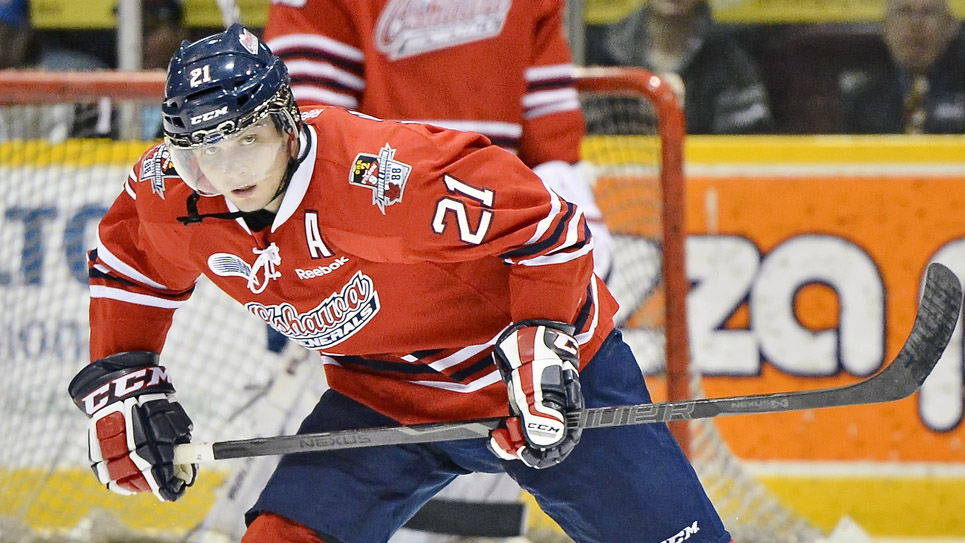Scott Laughton isn’t the biggest name on Canada’s under-20 roster. Yeah, he was a first-rounder last year, 20th overall, but you could have easily missed that unless you’re a Philadelphia fan or an Oshawa Generals season-ticket holder. And even if you are a Flyers fan you probably don’t remember the handful of regular-season games he spent on the roster of the big club.
So when Hockey Canada named Laughton as captain of the U20 team in Sweden over these holidays, you’d have a couple of reactions. One: Scott who? Two: Why him?
To answer the first question, Laughton is a hyper-competitive forward who scored 12, 21 and 23 goals in his first three major junior seasons — decent numbers but nothing that distinguishes him from dozens of CHL players. He has broken through in a big way this year: 24 goals and 26 assists in 29 games. Still, no one is mentioning him in the same breath as Halifax’s Jonathan Drouin or other elite players on hand.
Laughton has some utility in the fact that it seems like he can move over from centre to wing. In a short tournament with a fixed roster and with the prospect of injury, someone who can move from position to position, from fourth line up to the top two, who can both finish a chance or finish a check, offers you some much-needed flexibility. Even at that, though, it doesn’t sound like the stuff of which tournament heroes are made. It still leaves you asking No. 2: Why would you go with Laughton over a returning player such as Drouin, or defenceman Griffin Reinhart, or all the other red-blooded Canadian teens?
One NHL scout’s thumbnail description of Laughton didn’t provide any answer: “A good junior, maybe a useful NHLer down the line but I have a hard time seeing him as anyone who’d have a role on the top six of a winning team.”
Dead end there.
So I asked Oshawa GM Jeff Twohey about Laughton. Not exactly an impartial observer to be sure, but he’d be someone who knows Laughton better than almost anybody, including the Flyers. Twohey was predictably effusive in his praise of his guy. He said Laughton was “a quiet leader, a leader by example more than words but a kid not afraid to speak up and call someone out if it’s necessary.” Yeah, but, well, we can probably say that about half the kids who came to the selection camp.
Twohey drew on his own history as the former GM of the Peterborough Petes when asked for players who fit in Laughton’s profile. “I had Jamie Langenbrunner in Peterborough and Scott has the same sort of intensity that Jamie did,” Twohey said. “It’s the type of intensity that you might not be comfortable with when the player is younger, before he makes junior. Scott’s compete level is like Chris Pronger’s was. Even with all the skill, he takes it right up to full commitment and even meanness. Whatever it takes to get it done, he’s prepared to do it. And my experience has been that his attitude is contagious. Teammates feed off it.”
That starts to go to what you’d be looking for in a player wearing a ‘C’ on a sweater bearing the Hockey Canada leaf. And Laughton’s influence might explain why Oshawa, in what was supposed to be a rebuilding season, has shown the way in the Eastern Conference. Still, you find yourself doubling back to question No. 1: Who is this guy?
Three things jump out as Twohey told it.
The first is loyalty: “He’s a GTHL player but unlike almost all the kids that come out of the league, Scott played his entire career with one organization, the Toronto Marlies. Other kids bounce around and look for the next best thing and Scott stuck it out whether the team was up or down.”
The second is his ability to communicate: “Most kids who come into the arena walk right by my office to go to the dressing room and they usually keep their heads down. Some make eye contact and say hi but want to keep right on going. Scott will stop in almost every time and talk — it might just be small talk or stuff not to do with the team at all. And it’s the same way he engages with his teammates. He’s a low-maintenance kid but he’s not off in a bubble either.”
The third, and probably the most important, is his ability to avoid getting rattled: “This year he got sent down by the Flyers when he thought he had made the team. It had to be a huge disappointment. He’s going from travelling on charters to the bus, you know. Most kids struggle with it — when they’ve been sent back to junior from camp, especially when they think they have a shot at the team. We had a game that night and I thought, ‘He’ll just get through the game and adjust later when he’s processed it.’ It was a difficult situation. He travelled during the day (he was sent down) and then played for us that night. And he was the best player on the ice. What could have easily knocked him down raised his game. He didn’t skip a beat. There had to be a big emotional swing but he left it at the dressing (room) door.”
That sort of resilience comes in handy at a tournament like the world juniors.

